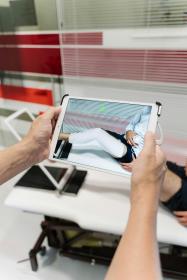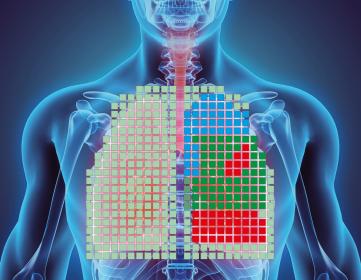Wearable Robots for Parkinson’s Disease
Freezing is one of the most common and debilitating symptoms of Parkinson’s disease, a neurodegenerative disorder that affects more than 9 million people worldwide. When individuals with Parkinson’s disease freeze, they suddenly lose the ability to move their feet, often mid-stride, resulting in a series of staccato stutter steps that get shorter until the person stops altogether. These episodes are one of the biggest contributors to falls among people living with Parkinson’s disease.
Today, freezing is treated with a range of pharmacological, surgical or behavioral therapies, none of which are particularly effective. What if there was a way to stop freezing altogether?
Researchers from the Harvard John A. Paulson School of Engineering and Applied Sciences (SEAS) and the Boston University Sargent College of Health & Rehabilitation Sciences have used a soft, wearable robot to help a person living with Parkinson’s walk without freezing. The robotic garment, worn around the hips and thighs, gives a gentle push to the hips as the leg swings, helping the patient achieve a longer stride.
The device completely eliminated the participant’s freezing while walking indoors, allowing them to walk faster and further than they could without the garment’s help.
“We found that just a small amount of mechanical assistance from our soft robotic apparel delivered instan-taneous effects and consistently improved walking across a range of conditions for the individual in our study,” said Conor Walsh, the Paul A. Maeder Professor of Engineering and Applied Sciences at SEAS and co-corresponding author of the study.
The research demonstrates the potential of soft robotics to treat this frustrating and potentially dangerous symptom of Parkinson’s disease and could allow people living with the disease to regain not only their mobility but their independence.
For over a decade, Walsh’s Biodesign Lab at SEAS has been developing assistive and rehabilitative robotic technologies to improve mobility for individuals’ post-stroke and those living with ALS or other diseases that impact mobility. Some of that technology, specifically an exosuit for post-stroke gait retraining, received support from the Wyss Institute for Biologically Inspired Engineering, and Harvard’s Office of Technology Development coordinated a license agreement with ReWalk Robotics to commercialize the technology.
In 2022, SEAS and Sargent College received a grant from the Massachusetts Technology Collaborative to support the development and translation of next-generation robotics and wearable technologies. The research is centered at the Move Lab, whose mission is to support advances in human performance enhancement with the collaborative space, funding, R&D infrastructure, and experience necessary to turn promising research into mature technologies that can be translated through collaboration with industry partners. This research emerged from that partnership.
“Leveraging soft wearable robots to prevent freezing of gait in patients with Parkinson’s required a collaboration between engineers, rehabilitation scientists, physical therapists, biomechanists and apparel designers,” said Walsh, whose team collaborated closely with that of Terry Ellis, Professor and Physical Therapy Department Chair and Director of the Center for Neurorehabilitation at Boston University.
Leveraging soft wearable robots to prevent freezing of gait in patients with Parkinson’s required a collaboration between engineers, rehabilitation scientists, physical therapists, biomechanists and apparel designers.
The team spent six months working with a 73-year-old man with Parkinson’s disease, who — despite using both surgical and pharmacologic treatments — endured substantial and incapacitating freezing episodes more than 10 times a day, causing him to fall frequently. These episodes prevented him from walking around his community and forced him to rely on a scooter to get around outside.
In previous research, Walsh and his team leveraged human-in-the-loop optimization to demonstrate that a soft, wearable device could be used to augment hip flexion and assist in swinging the leg forward to provide an efficient approach to reduce energy expenditure during walking in healthy individuals.
Here, the researchers used the same approach but to address freezing. The wearable device uses cable-driven actuators and sensors worn around the waist and thighs. Using motion data collected by the sensors, algorithms estimate the phase of the gait and generate assistive forces in tandem with muscle movement.
The effect was instantaneous. Without any special training, the patient was able to walk without any freezing indoors and with only occasional episodes outdoors. He was also able to walk and talk without freezing, a rarity without the device.
“Our team was really excited to see the impact of the technology on the participant’s walking,” said Jinsoo Kim, former PhD student at SEAS and co-lead author on the study.
During the study visits, the participant told researchers: “The suit helps me take longer steps and when it is not active, I notice I drag my feet much more. It has really helped me, and I feel it is a positive step forward. It could help me to walk longer and maintain the quality of my life.”
“Our study participants who volunteer their time are real partners,” said Walsh. “Because mobility is difficult, it was a real challenge for this individual to even come into the lab, but we benefited so much from his perspective and feedback.”
The device could also be used to better understand the mechanisms of gait freezing, which is poorly understood.
“Because we don’t really understand freezing, we don’t really know why this approach works so well,” said Ellis. “But this work suggests the potential benefits of a ’bottom-up’ rather than ’top-down’ solution to treating gait freezing. We see that restoring almost-normal biomechanics alters the peripheral dynamics of gait and may influence the central processing of gait control.”
The research was co-authored by Jinsoo Kim, Franchino Porciuncula, Hee Doo Yang, Nicholas Wendel, Teresa Baker and Andrew Chin. Asa Eckert-Erdheim and Dorothy Orzel also contributed to the design of the technology, as well as Ada Huang, and Sarah Sullivan managed the clinical research. It was supported by the National Science Foundation under grant CMMI-1925085; the National Institutes of Health under grant NIH U01 TR002775; and the Massachusetts Technology Collaborative, Collaborative Research and Development Matching Grant.
The research is published in Nature Medicine.
Source Leah Burrows
Harvard John A. Paulson. School of Engineering and Applied Sciences
















